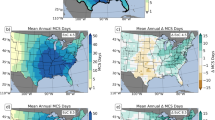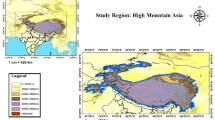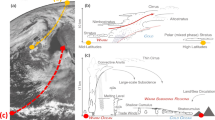Abstract
The effects of doubled carbon dioxide on rainfall responses to radiative processes of water clouds are investigated in this study. Two groups of two-dimensional cloud-resolving model sensitivity experiments with regard to pre-summer heavy rainfall around the summer solstice and tropical rainfall around the winter solstice are conducted and their five-day averages over the model domain are analyzed. In the presence of radiative effects of ice clouds, doubled carbon dioxide changes pre-summer rainfall from the decrease associated with the enhanced atmospheric cooling to the increase associated with the enhanced infrared cooling as a result of the exclusion of radiative effects of water clouds. Doubled carbon dioxide leads to the reduction in tropical rainfall, caused by the removal of radiative effects of water clouds through the suppressed infrared cooling. In the absence of radiative effects of ice clouds, doubled carbon dioxide changes pre-summer rainfall from the increase associated with the strengthened atmospheric warming to the decrease associated with the weakened release of latent heat caused by the elimination of radiative effects of water clouds. The exclusion of radiative effects of water clouds increases tropical rainfall through the strengthened infrared cooling, which is insensitive to the change in carbon dioxide.
Similar content being viewed by others
References
Bazzaz, F. A., 1990: The response of natural ecosystems to the rising global CO2 levels. Annual Review of Ecological and Systematics, 21, 167–196.
Brunke, M. A., Z. Wang, X. Zeng, et al., 2011: An assessment of the uncertainties in ocean surface turbulent fluxes in 11 reanalysis, satellite-derived, and combined global datasets. J. Climate, 24, 5469–5493.
Chen, G., and I. M. Held, 2007: Phase speed spectra and the recent poleward shift of Southern Hemisphere surface westerlies. Geophys. Res. Lett., 34, L21805, doi: 10.1029/2007GL031200.
Chou, M.-D., D. P. Kratz, and W. Ridgway, 1991: Infrared radiation parameterization in numerical climate models. J. Climate, 4, 424–437.
—, and M. J. Suarez, 1994: An efficient thermal infrared radiation parameterization for use in general circulation models. NASA Tech. Memo. 104606, Vol. 3, 85 pp. [Available from NASA/Goddard Space Flight Center, Code 913, Greenbelt, MD 20771]
—, —, C.-H. Ho, et al., 1998: Parameterizations for cloud overlapping and shortwave single scattering properties for use in general circulation and cloud ensemble models. J. Climate, 11, 201–214.
Emori, S., and S. J. Brown, 2005: Dynamic and thermodynamic changes in mean and extreme precipitation under changed climate. Geophys. Res. Lett., 32, doi:.1029/2005GL023272.
Fields, P. A., J. B. Graham, R. H. Rosenblatt, et al., 1993: Effects of expected global climate change on marine faunas. Trends in Ecology and Evolution, 8, 361–367.
Folland, C. K., N. A. Rayner, S. J. Brown, et al., 2001: Global temperature change and its uncertainties since 1861. Geophys. Res. Lett., 28, 2621–2624.
Gao, S., and X. Li, 2008: Cloud-Resolving Modeling of Convective Processes. Springer, Dordrecht, 206 pp.
IPCC, 2001: Climate Change 2001: The Scientific Basis. Contribution of Working Group I to the Third Assessment Report of International Panel on Climate Change, Houghton et al., Eds., Cambridge University Press, Cambridge and New York, 572 pp.
—, 2007: Climate Change 2007: Mitigation of Climate Change. Contribution of Working Group III to the Fourth Assessment Report of the Intergovernmental Panel on Climate Change, B. Metz et al., Eds., Geneva, Switzerland, 852 pp.
Liu, J., X. Shen, and X. Li, 2014: Radiative effects of water clouds on heat, cloud microphysical and surface rainfall budgets associated with pre-summer torrential rainfall. Terr. Atmos. Oceanic Sci., 25, 41–50.
Jones, P. D., and A. Moberg, 2003: Hemispheric and large-scale surface air temperature variations: An extensive revision and an update to 2001. J. Climate, 16, 206–223.
Kharin, V., and F. Zwiers, 2005: Estimating extremes in transient climate change simulations. J. Climate, 18, 1156–1173.
Krueger, S. K., Q. Fu, K. N. Liou, et al., 1995: Improvement of an ice-phase microphysics parameterization for use in numerical simulations of tropical convection. J. Appl. Meteor., 34, 281–287.
Kumar, A., and Z.-Z. Hu, 2012: Uncertainty in the oceanatmosphere feedbacks associated with ENSO in the reanalysis products. Climate Dyn., 39, 575–588.
Li Hongmei, Feng Lei, and Zhou Tianjun, 2011: Multimodel projection of July–August climate extreme changes over China under CO2 doubling. Part I: Precipitation. Adv. Atmos. Sci., 28, 433–447.
Li, X., and X. Shen, 2010: Sensitivity of cloud-resolving precipitation simulations to uncertainty of vertical structures of initial conditions. Quart. J. Roy. Meteor. Soc., 136, 201–212.
—, C.-H. Sui, K.-M. Lau, et al., 1999: Large-scale forcing and cloud-radiation interaction in the tropical deep convective regime. J. Atmos. Sci., 56, 3028–3042.
—, —, and —, 2002a: Interactions between tropical convection and its embedding environment: An energetics analysis of a 2-D cloud resolving simulation. J. Atmos. Sci., 59, 1712–1722.
—, —, and —, 2002b: Dominant cloud microphysical processes in a tropical oceanic convective system: A 2-D cloud resolving modeling study. Mon. Wea. Rev., 130, 2481–2491.
—, S. L. Zhang, and D.-L. Zhang, 2006: Thermodynamic, cloud microphysics and rainfall responses to initial moisture perturbations in the tropical deep convective regime. J. Geophys. Res., 111, D14207, doi:.1029/2005JD006968.
Li Xiaofan, Shen Xinyong, and Liu Jia, 2014: Effects of doubled carbon dioxide on rainfall responses to the large-scale forcing: A two-dimensional cloudresolving modeling study. Adv. Atmos. Sci., 31, 525–531, doi: 10.1007/s00376-013-3030-2.
Lin, Y.-L., R. D. Farley, and H. D. Orville, 1983: Bulk parameterization of the snow field in a cloud model. J. Clim. Appl. Meteor., 22, 1065–1092.
Liu, J., X. Y. Shen, and X. F. Li, 2014: Radiative effects of water clouds on heat, cloud microphysical and surface rainfall budgets associated with pre-summer torrential rainfall. Terr. Atmos. Ocean. Sci., 25, 41–50.
Manabe, S., and R. T. Wetherald, 1975: The effects of doubling the CO2 concentration on the climate of a general circulation model. J. Atmos. Sci., 32, 3–15.
Meehl, G. A., J. M. Arblaster, and C. Tebaldi, 2005: Understanding future patterns of increased precipitation intensity in climate model simulations. Geophys. Res. Lett., 32, doi:.1029/2005GL023680.
Ran, L. K., and X. F. Li, 2014: Sensitivity of cloudresolving precipitation simulations to uncertainty of radiation calculation: Effects of large-scale forcing. Quart. J. Roy. Meteor. Soc., 140, 838–845, doi: 10.1002/qj.2203.
Rutledge, S. A., and P. V. Hobbs, 1983: The mesoscale and microscale structure and organization of clouds and precipitation in midlatitude cyclones. Part VIII: A model for the “seeder-feeder” process in warmfrontal rainbands. J. Atmos. Sci., 40, 1185–1206.
—, and —, 1984: The mesoscale and microscale structure and organization of clouds and precipitation in midlatitude cyclones. Part XII: A diagnostic modeling study of precipitation development in narrow cold-frontal rainbands. J. Atmos. Sci., 41, 2949–2972.
Shen, X., Y. Wang, and X. Li, 2011a: Radiative effects of water clouds on rainfall responses to the largescale forcing during pre-summer heavy rainfall over southern China. Atmos. Res., 99, 120–128.
—, —, and X. F. Li, 2011b: Effects of vertical wind shear and cloud radiatve processes on responses of rainfall to the large-scale forcing during pre-summer heavy rainfall over southern China. Quart. J. Roy. Meteor. Soc., 137, 236–249.
—, N. Zhang, and X. Li, 2011c: Effects of large-scale forcing and ice clouds on pre-summer heavy rainfall over southern China in June 2008: A partitioning analysis based on surface rainfall budget. Atmos. Res., 101, 155–163.
Soong, S. T., and Y. Ogura, 1980: Response of trade wind cumuli to large-scale processes. J. Atmos. Sci., 37, 2035–2050.
—, and W.-K. Tao, 1980: Response of deep tropical cumulus clouds to mesoscale processes. J. Atmos. Sci., 37, 2016–2034.
Sui, C.-H., K.-M. Lau, W.-K. Tao, et al., 1994: The tropical water and energy cycles in a cumulus ensemble model. Part I: Equilibrium climate. J. Atmos. Sci., 51, 711–728.
—, X. Li, and K.-M. Lau, 1998: Radiative-convective processes in simulated diurnal variations of tropical oceanic convection. J. Atmos. Sci., 55, 2345–2359.
Tao, W.-K., and J. Simpson, 1993: The Goddard cumulus ensemble model. Part I: Model description. Terr. Atmos. Oceanic Sci., 4, 35–72.
—, —, and M. McCumber, 1989: An ice-water saturation adjustment. Mon. Wea. Rev., 117, 231–235.
Tebaldi, C., K. Hayhoe, J. Arblaster, et al., 2006: Going to the extremes: An intercomparison of modelsimulated historical and future changes in extreme events. Climatic Change, 79, 185–211.
Vecchi, G. A., and B. J. Soden, 2007: Global warming and the weakening of the tropical circulation. J. Climate, 20, 4316–4340.
Wang, Y., X. Shen, and X. Li, 2010: Microphysical and radiative effects of ice clouds on responses of rainfall to the large-scale forcing during pre-summer heavy rainfall over southern China. Atmos. Res., 97, 35–46.
Weller, R. A., and S. P. Anderson, 1996: Surface meteorology and air-sea fluxes in the western equatorial Pacific warm pool during TOGA COARE. J. Climate, 9, 1959–1990.
Wu, Y. T., R. Seager, M. F. Ting, et al., 2012: Atmospheric circulation response to an instantaneous doubling of carbon dioxide. Part I: Model experiment and transient thermal response in the troposphere. J. Climate, 25, 2862–2879.
Author information
Authors and Affiliations
Corresponding author
Additional information
Supported by the National Natural Science Foundation of China (41475039) and National Key Basic Research and Development (973) Program of China (2015CB953601).
Rights and permissions
About this article
Cite this article
Li, X., Li, T. & Lou, L. Effects of doubled carbon dioxide on rainfall responses to radiative processes of water clouds. J Meteorol Res 28, 1114–1126 (2014). https://doi.org/10.1007/s13351-014-4043-1
Received:
Accepted:
Published:
Issue Date:
DOI: https://doi.org/10.1007/s13351-014-4043-1




